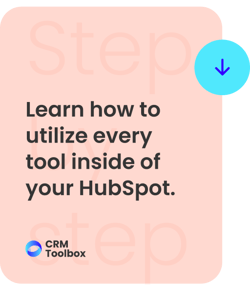Subscribe to ur Blog

Over many years of helping companies implement and grow their business using HubSpot, we've come across some common mistakes that are made through omission or a lack of knowledge of the platform itself. It's not uncommon to find customers so frustrated with the tool that, once we sat down with them, we discovered that their problem wasn't really HubSpot itself, but how they were using it.
And no matter how powerful HubSpot is, it's also important to consider that with great resources and features comes a bit of complexity.
So whether you're currently using HubSpot or planning to purchase the tool, it's definitely important that you pay attention that you're not making the following mistakes:
1. Not Managing Expectations

One of the main issues we ran into is how clients were expecting something the tool cannot give, at least not without their help. Many have the expectation that a CRM that specialized in sales and marketing automation, is an out-of-the-box solution. However, without the correct implementation, the results are not going to appear out of the blue.
Another important point with expectations is what you as a leader expect from this tool and how you communicate that to your collaborators. If the expected results and goals are not communicated to the entire team, you will inevitably create unnecessary friction.
In short, it is crucial to be clear about what you expect from the platform and to communicate that clearly to your team as soon as possible. This will convert everyone involved into early adopters, making HubSpot’s role feel like a solution that will help everyone achieve their goals.
2. Not Having A Clean Database
The power of your CRM depends primarily on the data you feed it, so starting with an unorganized foundation will limit everything you do going forward. A poor quality database and having no data at all do the same amount of damage to your strategy, meaning a clean database is vital. To achieve that, the first step is to deduplicate your contacts, since having more than one contact assigned to the same account can generate friction for them, giving you a false scope towards clients and prospects. Duplicate happens if you don’t standardize data capture if you use different information sources and if you set up forms incorrectly.
3. Not Customizing
One of the great advantages that comes with HubSpot is its flexibility which can sometimes depend on the Hub you have contracted. When it comes to customizing the platform to your needs, custom objects are key. They should be implemented from the start because they help you create an experience focused on your customers and prospects.
4. Using Contact Records for Companies and Organizations
Although it might seem tempting (and very easy) to use the contact properties to register a company, it is a bad idea to do so, because it reduces the quality of your campaigns and directly affects your database. The pre-established figures in HubSpot will be the key to the success of your strategy, contact records will not.
5. Not Having A Defined Sales Process
How can you automate a process that doesn't exist? You don’t. You can't expect HubSpot to help you automate non-existent processes. When there are no standardizations in the processes, the ones who suffer the most are the customers since not everyone receives the same treatment.
Before diving into technology and tools, you need to completely map out your sales process to gain the most out of HubSpot. You should know the times of each stage, what causes a change of stage, and how the process continues.
Once this flow is well defined, it's time to map out how it would look in HubSpot based on the custom fields used, the rules for lead assignment, and when the transition from marketing to sales takes place in your plan.
6. Not Aligning HubSpot with your Processes and Flows
Once you have your sales processes clear, it is time to align the platform to match that plan. If you're already using HubSpot as your CRM, then it should be the connecting point between your team, clients, and prospects. When a CRM is used as a tool to unify processes and give customers a better experience, the ultimate benefits are revealed.
7. Not Having A Customer-Centric Strategy
Shockingly, the belief that marketing and sales should revolve around a brand instead of the customer still happens today. When you hire a CRM like HubSpot, you have to be sure that your approach is not that one, because the platform is created with the end customer in mind. If you expect the customer to buy what you want to sell just because then HubSpot probably won't help you with this. HubSpot is a platform you should use to understand and serve your prospects and customers by listening to their needs.
8. Not Integrating Your Tech Stack
HubSpot is only as powerful as the sum of its parts. Although several of the tools you need are included directly with HubSpot, there are many companies that work with other digital marketing tools to reach their goals. These external resources have to be integrated into the platform so that the information flows correctly.
Whether it is about information flows, data storage, web forms, or automation tools, your CRM should not center on sales alone, but focus on marketing, sales, and customer service as a whole.
Remember, a CRM should be the primary basis of your customer relationship strategy, but it will not be the only tool you use. Make sure it can be integrated with the rest of your tools before committing to any provider.
9. Focusing On Price
If you're going to use HubSpot’s free version because it's free, you should know that, if it is not what you need for your company, it will not work for you. On the other hand, if you are looking through the paid options, remember the difference between costly/profitable and expensive. While the cost might seem high for Professional or Enterprise level Hubs, the success that comes with them makes them almost immediately profitable.
When purchasing HubSpot, bear in mind that it is more than just a database. It is a comprehensive system that brings together your customer's and prospects’ data with the most powerful automation and integrations on the market.
However, it's important to note that making HubSpot work requires effort on your part. You will need to feed the platform with the correct data, create the right content strategy, and design automation that makes the most of HubSpot's features.
10. Ignoring Feedback
There are two main places where you should value feedback the most. First, you should receive feedback from your collaborators who are using the tool. It is easy to believe that everything is working accordingly, but this should always be checked. By ignoring your team’s comments and suggestions, you will run into unnecessary friction.
Secondly, it’s crucial to listen to your customers and prospects who express their options on what could be improved about your product or service.
11. Not Working With A Partner Agency
Although you can implement everything on your own, HubSpot is a complex tool with countless moving parts. Therefore, it is best to ask for help when you need it. An implementation is the foundation of your CRM. Not having it done well from the beginning can be more costly than you think and it is likely that you would end up going to a specialist anyway.
In short, errors with HubSpot usually depend on how the platform is used. If you are considering HubSpot as a solution for your business, we can have a conversation and talk about what your company's challenges are and how you see HubSpot's participation in your planning. I would love to hear the frictions and expectations of your company in order to help you define the best way forward.
Related Reads
Master HubSpot tools & unleash a world of endless possibilities!
Unlock Your HubSpot Powerhouse: Contact Us to Transform Your Digital Journey!

Ranya Barakat
Ranya is a serial entrepreneur with over 8 years of experience working on the HubSpot CRM. She loves pushing her sleeves up , and getting s*** done. When she is not running her HubSpot partner agency, you can find her upside down on her yoga mat.
Subscribe to our blog
The best information about inbound marketing, sales, guides and migrations.



